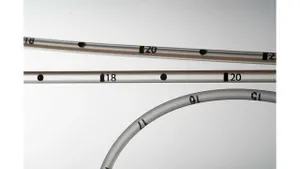Do rotating cubes stack up to expectations?
Rotating cube molds (also known as “stack cube” molds) have a long history but not necessarily a history of commercial success. While the technology for these molds has evolved over the past decade resulting in various patents by a number of mold manufacturing companies and even OEMs, rotating cube molds are not ubiquitous in molding. In fact, the actual market for these complex rotating stack molds that can do everything except the dirty dishes, remains sluggish.
September 4, 2013
In some cases, OEMs have found that the rotating cube molds are not as efficient as stack molds with the secondary operations done post-molding. Is it worth the cost – in both cycle time and money – to choose a rotating cube mold over a stack mold? The applications that make the rotating cube mold optimal tend to be very specific, and require evaluating the alternatives before OEMs choose this technology.
When Gram Technology Inc. (www.gramtechnology.com) received its Notice of Allowance from the U.S. Patent and Trademark Office for its proprietary Spin-Stack In-Mold Assembly Technology in 2006, it helped the company validate its technology that was introduced in the U.S. in 2003 at both the Molding 2003 conference and at NPE 2003. Gram licenses its Spin-Stack technology to companies wanting to use this innovation.
European mold manufacturers were on the cutting edge of these rotating stack/cube molds. A European patent was filed Dec. 2, 2008 by Richard La Torre for Siemens Healthcare Diagnostics Inc. He called the title of his invention the “Multi-Cube, Stack-Turning, Injection Molding System for In-Mold Assembly. La Torre cited moldmaker Foboha GmbH (Haslachin, Germany) in the background information, which employed “stack-turning” injection molding systems “that simultaneously perform injection, cooling, and assembly steps in a continuous cycle by rotating a stack (‘cube’) about an axis of rotation.”
La Torre’s mold patent was for a method of mechanically joining, adhesively joining or solvent bonding the exposed edges of two halves of the plastic parts. It was La Torre’s idea to do what he claimed in his patent filing that had not been done before and that is perform in-mold assembly of hermetically sealed products.
Foboha (www.advaltech.com) patented its double-turning-cube stack mold system in December of 2004, but has been working on this technology for more than 15 years, according to Hansjorg Keusgen, Executive Management Sales & Marketing for Foboha. Originally developed with Ferromatik, the Foboha cube mold rotates horizontally in 90-degree increments. At each turn, a different operations take place: label insertion, molding, cooling, demolding for IML production.
A hydraulic or servo motor indexes the center section in 1.3 seconds with a programmable acceleration/deceleration profile. There are three parting lines all in one injection molding machine to mold two precisions parts from two materials, label, and assemble the finished product. “Foboha is the only company that is building the turning device for the turning stack with a top and bottom unit,” Keusgen told PlasticsToday. “This allows the Foboha system to run faster and more reliably than other systems. Also, the wear on the mold is much less compared to systems that are not top- and bottom-guided systems.
Every year, Foboha (which is celebrating its 40th anniversary and is a member of Adval Tech Group), builds over 120 complex molds for the packaging, medical, personal care and automotive industries, and has filed more than 80 international patents. More than 50% of Foboha’s mold sales involve high-tech cube molds, with 90% of those exported, most going to U.S. markets, followed by Asia and Europe, according to company information. Foboha's recent developments in cube molds are the “Twin Cube” system with a synchronized combination of two counter-rotating cubes between the two mold halves, and a fully electric stack turning mold.
“The Foboha cube technology offers a very efficient way to produce high-volume plastic parts in multi-color or even for single color as an alternative to conventional stack molds,” said Keusgen. “High output, part quality, part design and the overall product cost are the main focus our customers have when they decide to go with the Foboha cube."
In March 2011, Husky Injection Molding Systems (www.husky.ca) acquired mold manufacturer KTW, a well-known closure mold manufacturer headquartered in Waidhofen, Austria (now Husky’s Closures Center of Excellence). EASYcube is a Husky/KTW trademarked technology. “As a part of a complete Husky system, this is a great example of what Husky and KTW can achieve together,” said Henry Zhang, Husky’s market manager.
Zhang told PlasticsToday that the EASYcube differs from other cube mold technology in that it enables fast mold changeover and installation. “Its compact mold design allows it to be installed like a stack mold, providing faster changeover time than a conventional cube mold,” he said. “While EASYcube is specifically designed to provide the best platform for molding multi-material closures, it can be applied to a variety of other applications, including multi-color component closures, in-mold assembly, in-mold labeling and additional cooling stations.”
Also, unlike the traditional cube mold, EASYcube has a well-structured frame that protects the stack component, which greatly reduces the probability of key components being damaged during installation and transportation. It provides flexibility as well in that EASYcube does not require a special molding machine or equipment, but can be installed in standard molding machines. “It does not require specialized platen openings,” Zhang said.
Zahoransky Formenbau GmbH, (www.zahoransky-group.com) introduced what it called “a totally new cube technology” at the 2011 Fakuma show. The new patented in-mold assembly method known as TIM Stack (Total Integrated Manufacturing) consists of two mold halves with an axial rotary cube in the middle and two assembly platens located outside the mold to allow for “complex assembly processes to be performed externally from the mold without increasing molding cycle time.”
See Foboha at the upcoming K 2013 in Hall 01/Stand A24, and Zahoransky Group in Hall 02/Stand A02.
About the Author(s)
You May Also Like




